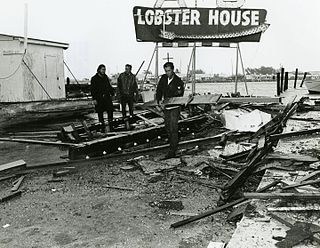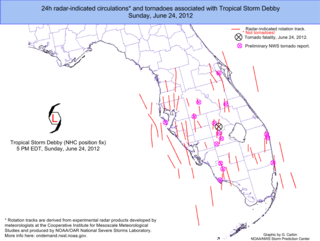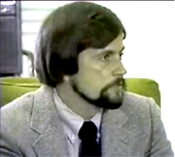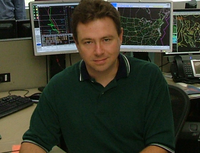
A tornado is a violently rotating column of air that is in contact with both the surface of the Earth and a cumulonimbus cloud or, in rare cases, the base of a cumulus cloud. It is often referred to as a twister, whirlwind or cyclone, although the word cyclone is used in meteorology to name a weather system with a low-pressure area in the center around which, from an observer looking down toward the surface of the Earth, winds blow counterclockwise in the Northern Hemisphere and clockwise in the Southern. Tornadoes come in many shapes and sizes, and they are often visible in the form of a condensation funnel originating from the base of a cumulonimbus cloud, with a cloud of rotating debris and dust beneath it. Most tornadoes have wind speeds less than 180 kilometers per hour, are about 80 meters across, and travel several kilometers before dissipating. The most extreme tornadoes can attain wind speeds of more than 480 kilometers per hour (300 mph), are more than 3 kilometers (2 mi) in diameter, and stay on the ground for more than 100 km (62 mi).
The Fujita scale, or Fujita–Pearson scale, is a scale for rating tornado intensity, based primarily on the damage tornadoes inflict on human-built structures and vegetation. The official Fujita scale category is determined by meteorologists and engineers after a ground or aerial damage survey, or both; and depending on the circumstances, ground-swirl patterns, weather radar data, witness testimonies, media reports and damage imagery, as well as photogrammetry or videogrammetry if motion picture recording is available. The Fujita scale was replaced with the Enhanced Fujita scale (EF-Scale) in the United States in February 2007. In April 2013, Canada adopted the EF-Scale over the Fujita scale along with 31 "Specific Damage Indicators" used by Environment Canada (EC) in their ratings.

A meteorologist is a scientist who studies and works in the field of meteorology aiming to understand or predict Earth's atmospheric phenomena including the weather. Those who study meteorological phenomena are meteorologists in research, while those using mathematical models and knowledge to prepare daily weather forecasts are called weather forecasters or operational meteorologists.

A tornado watch is a severe weather watch product of the National Weather Service that is issued by national weather forecasting agencies when meteorological conditions are favorable for the development of severe thunderstorms capable of producing tornadoes. In addition to the potential for tornado development, thunderstorms that develop within the watch area may contain large hail, straight-line winds, intense rainfall and/or flooding that pose a similar damage risk as the attendant tornado threat. A tornado watch does not mean a tornado is active or will appear, just that favorable conditions increases the likelihood of such happening. A watch must not be confused with a tornado warning.

The National Weather Service (NWS) is an agency of the United States federal government that is tasked with providing weather forecasts, warnings of hazardous weather, and other weather-related products to organizations and the public for the purposes of protection, safety, and general information. It is a part of the National Oceanic and Atmospheric Administration (NOAA) branch of the Department of Commerce, and is headquartered in Silver Spring, Maryland, within the Washington metropolitan area. The agency was known as the United States Weather Bureau from 1890 until it adopted its current name in 1970.

Storm chasing is broadly defined as the deliberate pursuit of any severe weather phenomenon, regardless of motive, but most commonly for curiosity, adventure, scientific investigation, or for news or media coverage. A person who chases storms is known as a storm chaser or simply a chaser.

The Storm Prediction Center (SPC) is a US government agency that is part of the National Centers for Environmental Prediction (NCEP), operating under the control of the National Weather Service (NWS), which in turn is part of the National Oceanic and Atmospheric Administration (NOAA) of the United States Department of Commerce (DoC).
On February 21–23, 1998, a devastating tornado outbreak affected portions of the Southeastern United States, primarily the U.S. state of Florida. Sometimes known as the Night of the Tornadoes, it was the deadliest tornado event in Florida history. In all, 15 tornadoes touched down, one of which was long lived and tracked for nearly 40 miles (64 km). Affecting mainly the Interstate 4 (I-4) corridor of Central Florida, including the Greater Orlando area, the tornadoes—among the strongest ever recorded in Florida—produced near-violent damage, killed 42 people, and caused 259 injuries.
Gandikota V. Rao was an Indian-American atmospheric scientist who chaired the Department of Earth and Atmospheric Sciences at Saint Louis University (SLU). He was a world-renowned expert on tropical meteorology, monsoon, tropical cyclones, and tropical cyclone tornadoes. He was also known for work on air pollution, atmospheric convection, atmospheric boundary layers, and numerical weather prediction.

The Verification of the Origins of Rotation in Tornadoes Experiment are field experiments that study tornadoes. VORTEX1 was the first time scientists completely researched the entire evolution of a tornado with an array of instrumentation, enabling a greater understanding of the processes involved with tornadogenesis. A violent tornado near Union City, Oklahoma was documented in its entirety by chasers of the Tornado Intercept Project (TIP) in 1973. Their visual observations led to advancement in understanding of tornado structure and life cycles.

On June 18–19, 1972, Hurricane Agnes generated the third-deadliest tropical cyclone-related tornado outbreak in the United States since 1900, as well as the deadliest such tornado outbreak on record in Florida. The outbreak lasted about 38 hours and produced at least 19 confirmed tornadoes, though some studies suggested nearly a dozen more. Two of the tornadoes killed a total of seven people and were not classified as tornadoes by the National Weather Service until 2018. In Florida alone, the outbreak inflicted at least 135 injuries and destroyed 15 homes, while 119 homes received damage. Statewide, 217 trailers were destroyed and 196 trailers incurred damage. Additionally, six businesses were destroyed, while six others were damaged.
Howard Bruce Bluestein is a research meteorologist known for his mesoscale meteorology, severe weather, and radar research. He is a major participant in the VORTEX projects. A native of the Boston area, Dr. Bluestein received his Ph.D. in 1976 from MIT. He has been a professor of meteorology at the University of Oklahoma (OU) since 1976.
David K. Hoadley is an American pioneer of storm chasing and the first widely recognized storm chaser, as well as the founder and former editor of Storm Track magazine. He is also a sketch artist and photographer.

From June 23 to 26, 2012, Tropical Storm Debby produced a significant tornado outbreak across the Florida Peninsula. Throughout the entire event, 25 tornadoes touched down across the state, making the outbreak the second largest on record in Florida, behind only that spawned by Hurricane Agnes, which produced 28 tornadoes from June 18 to 19, 1972. At least ten of the tornadoes—the largest 24-hour total in South Florida since Hurricane Isbell produced eight in 1964—had been confirmed in four South Florida counties by the National Weather Service forecast office in Miami.

During the early evening of Friday, May 31, 2013, an extremely large and powerful tornado occurred over rural areas of Central Oklahoma. This rain-wrapped, multiple-vortex tornado was the widest tornado ever recorded and was part of a larger weather system that produced dozens of tornadoes over the preceding days. The tornado initially touched down at 6:03 p.m. Central Daylight Time (2303 UTC) about 8.3 miles (13.4 km) west-southwest of El Reno, rapidly growing in size and becoming more violent as it tracked through central portions of Canadian County. Remaining over mostly open terrain, the tornado did not impact many structures; however, measurements from mobile weather radars revealed extreme winds up to 135.0 m/s within the vortex. These are among the highest observed wind speeds on Earth, just slightly lower than the wind speeds of the 1999 Bridge Creek–Moore tornado. As it crossed U.S. 81, it had grown to a record-breaking width of 2.6 miles (4.2 km), beating the previous width record set in 2004. Turning northeastward, the tornado soon weakened. Upon crossing Interstate 40, the tornado dissipated around 6:43 p.m. CDT (2343 UTC), after tracking for 16.2 miles (26.1 km), it avoided affecting the more densely populated areas near and within the Oklahoma City metropolitan area.
The following is a glossary of tornado terms. It includes scientific as well as selected informal terminology.

Donald W. Burgess is an American meteorologist who has made important contributions to understanding of severe convective storms, particularly tornadoes, radar observations and techniques, as well as to training other meteorologists. He was a radar operator during the first organized storm chasing expeditions by the University of Oklahoma (OU) in the early 1970s and participated in both the VORTEX projects.

Alan Roger Moller was an American meteorologist, storm chaser, nature and landscape photographer known for advancing spotter training and bridging operational meteorology with research.

Hurricane Isbell spawned one of the most significant tornado outbreaks to strike the Miami metropolitan area on October 14, 1964. It produced at least nine confirmed, and possibly as many as 17, tornadoes, four of which were rated significant (F2) on the Fujita scale. Although there were no fatalities, 48 people were injured and losses totaled $560,250. The most damaging of the tornadoes was an estimated F2 that injured 22 people at a mobile home park in Briny Breezes, causing $250,000 in losses.

On October 3–4, 1964, Hurricane Hilda and its remnants generated a tornado outbreak over portions of the Southeastern United States. The outbreak, which yielded at least 12 confirmed tornadoes, killed 22 people and injured 175 others. Most of the casualties occurred as a result of a violent tornado that devastated the northern outskirts of Larose, Louisiana, becoming the deadliest hurricane-generated tornado on record since 1900 and one of only two violent tornadoes (F4+) recorded in the southern Gulf Coast region of Louisiana. The tornado was also one of only two F4s known to have been produced by a tropical cyclone, the other having occurred during Hurricane Carla on September 12, 1961.














